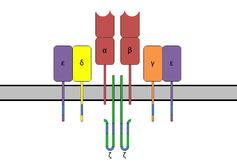Protein complex and T cell co-receptor
The T-cell receptor complexCD247 ) accessory molecules (bottom) and CD3 (represented by CD3γ , CD3δ and two CD3ε ). CD3 (cluster of differentiation 3) is a protein complex and T cell co-receptor that is involved in activating both the cytotoxic T cell (CD8+ naive T cells) and T helper cells (CD4+ naive T cells).[ 1] CD3γ chain, a CD3δ chain, and two CD3ε chains. These chains associate with the T-cell receptor (TCR) and the CD3-zeta (ζ-chain) to generate an activation signal in T lymphocytes . The TCR, CD3-zeta, and the other CD3 molecules together constitute the TCR complex.
